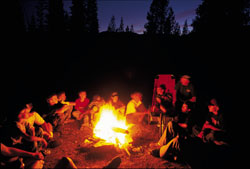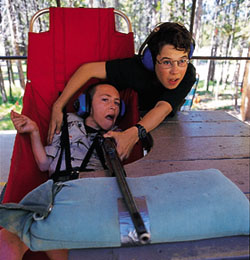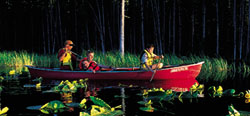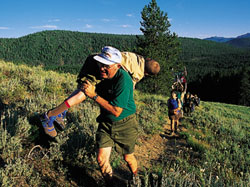![]() May-June 1999
May-June 1999
By Richard Romney
Photographs by Vince Heptig
 During a campfire, Michael and his father, Rick, help other Scouts understand the nature of his condition. Photograph by Vince Heptig, © 1999. |
Troop 202, chartered to Salt Lake City's St. Ambrose Parish of the Catholic Church, has a reputation as one of the most active units in the Great Salt Lake Council. Its Scouts always seem to be biking, hiking, camping, swimming, skiing, spelunking - you name it.
The boys also travel to a lot of exciting places. Recent destinations include Utah's Canyonlands National Park and Idaho's Sawtooth mountains, Catalina Island in California, Wyoming's Yellowstone National Park, Wind River mountains, Snake River, the Teton Range, and Philmont Scout Ranch in New Mexico.
And no matter what Troop 202 is doing or where they're going, you'll find 13-year-old Michael Augustine and his father, Rick, there, too.
Lots of fathers and sons enjoy Scouting together. But Michael has had cerebral palsy since birth, when he suffered trauma to the brain that trapped a smart mind in a body with physical challenges. He can't walk, talk more than to make noises, or feed himself without help.
Yet thanks to his dad and his troopmates, Michael is able to participate in just about everything. A few examples:
 With help from Elliot Faulkner, Michael sights a bull's-eye at he rifle range. Photograph by Vince Heptig, © 1999. |
Around a campfire that night, Rick Augustine explained his son's condition to some Scouts from other troops camping at Camp Bradley. He told them how Mike communicates by using eye movements to answer yes and no questions.
"One of the boys looked at Mike and asked,
 On a canoe outing, Michael rides with Mark Woodhead while Bryan Close (bow) and Brian Gillenwater paddle. Photograph by Vince Heptig, © 1999. |
Tom Patterson, 12, of Troop 90 from Twin Falls, Idaho, said: "It gave me a good feeling to see the guys in his troop helping him. That's what Scouting's all about."
The most lasting impressions, however, are those Michael has made on the members of his own troop.
"He teaches you respect," says J. P. Christenson, 13. "He's always ready, never late. He's always in full uniform. He's one of the best Scouts we've got."
"We just want to help him out," says Josh Schmeiser, 17. "It takes a little work and time, but
 When a trail gets too steep or narrow, Michael's dad carries him, while Scouts bring his chair. Photograph by Vince Heptig, © 1999. |
"He never stops trying," says Elliot Faulkner, 13. "He's taught me that you can't give up."
"I guess you could say he's just one of the guys," says Andrew Perkins, 17. "When I see him, I say, 'Hey, what's up?' just like I would to anybody else. I think that's what I'll remember the most from being in the troop - the camaraderie and the fact that Mike was included. He actually makes us a better troop."
First chartered in 1954, Troop 202 is a perennial Quality Unit Award winner that uses community pride, strong traditions, sound leadership, and a good troop committee to build both for now and the future.
"We try to keep our senior boys longer," explains Scoutmaster Dan Woodhead. "We have good activities to keep them involved, and we also use them as mentors to the younger Scouts. They pass along the tradition of pride as one of the top troops in our district."
Older Scouts also encourage the others to follow their example in supporting Michael's involvement in the troop.
"We tell them to not only think about 'What can the troop do for Mike,'" Andrew explains, "but also to ask, 'What will our help enable Mike to do for the troop?' Mike's helped all of us to understand that you can accept those who are different than you are. And that's made us all better people."
It comes as no surprise that one great troop and one great Scout work together so well.
And together they're setting a standard for all who follow: There are no limitations when you give it all you've got.
Richard Romney lives in Salt Lake City.
Troop Guides Play A Key Role in Troop 202's SuccessThat Michael Augustine was readily welcomed into Troop 202 and soon became an active member was not unusual. In fact, all new members receive special help and attention from older Scouts who have the leadership designation of troop guides. Troop 202 has
The latest edition of The Boy Scout Handbook informs new Scouts how it works: "The new-Scout patrol is a group of boys who have just become Scouts. They are helped by a troop guide - an older, experienced Scout who can show the way." An atmosphere of friendship"The boys who were troop guides for Michael - David Roper and David Veenstra - both helped him in Sunday school at church," Michael's father, Rick Augustine, remembers. "They both were already familiar with Michael when he came into the troop. They both extended a hand and set the tone. They told the rest of the troop: 'Hey, this can work. He can have fun and he can learn and do everything we can.'" "What it creates is an atmosphere of friendship," says George Pechmann, 15, who has just become a troop guide himself. "Everybody gets to know everybody and what it takes to get along with them. In Michael's case we learned that people like him don't act or think any differently than we do. So you don't treat Mike any different than anybody else, because really inside he's not." "This year we had 15 new Scouts," says Scoutmaster Dan Woodhead. "And our troop typically includes 40 to 50 boys. We use troop guides to make sure everyone feels included." |
Minor Adjustments Open a World of OpportunitiesTroop 202 used to meet in an upstairs room. Now they meet in the gym, because getting Michael Augustine's wheelchair up the stairs was difficult. That's a simple adjustment, but it typifies what Scouts - or any group - can do to include those who face physical challenges. Troop members and merit badge counselors have also learned to make
For example, Cody Cahall, 15, of Jerome, Idaho, the staff member in charge of pioneering and orienteering at Camp Bradley, made sure all questions could be answered by either yes or no. "With other Scouts I can ask, 'What's a contour line?'" he explained. "With Mike I have to say, 'Does a contour line show differences in elevation? If the answer is yes, look at your father. If the answer is no, look at me.'" "Michael will continue to grow and will probably be fairly close to a normal-size guy," explains his father, Rick. "With physical therapy, he'll also learn how to assist others as they help to move him and feed him. It hasn't damaged his mental capabilities, but his main means of communication will always be through what we call eye gaze, responding to questions by looking in a specific direction. "We're looking for some mechanical devices which will allow him to communicate through computers and voice synthesizer, but most of them use a hand or head control that he can't operate. When we find one he can use, his communication abilities will just skyrocket." In certain situations, alternate rank and merit badge requirements are possible for Scouts with disabilities (see Advancement Guidelines, BSA Supply No. 33088A). Additional information can be found in the publications listed below, available at local council service centers:
|
| The Boy Scouts of America | http://www.scouting.org |